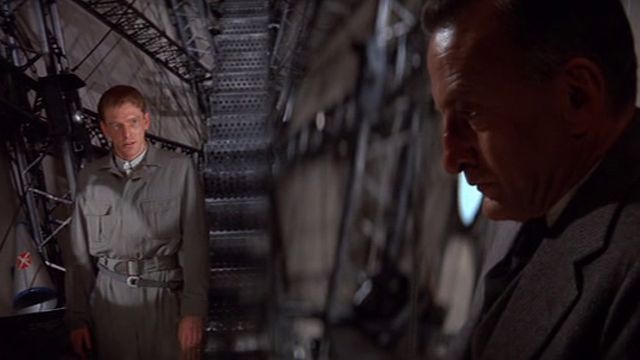The Hindenburg (1975) 
“Of 97 aboard, eight had a motive for sabotage. One had a plot.”

Director: Robert Wise
Cast: George C. Scott, Anne Bancroft, William Atherton
Synopsis: A film that chronicles the events of the Hindenburg disaster in which a zeppelin burst into flames.
The 1970s disaster movie genre was already running out of gas when The Hindenburg loomed ponderously into view; most A-listers who’d seen the opportunity for a sure-fire box office hit to add to their CV had already made their contribution. Newman and McQueen had played with fire, Hackman had splashed around in an overturned ship, and Heston had been shaken by an earthquake. So by 1975, director Robert Wise was only able to assemble a professional – but strictly second tier – quality of cast. That cast list is fairly symptomatic of the troubles that ail this production: everything comes across as second-rate, from the writing to the sets to the final disaster.
George C. Scott plays Ritter, a Luftwaffe colonel assigned the task of protecting the Third Reich’s prestigious dirigible, The Hindenburg, from various threats. He boards the ship for a voyage from Germany to America, along with the usual assortment of characters: a wealthy aristocrat (Anne Bancroft) opposed to the Nazi regime, a pair of card sharks (Burgess Meredith and Rene Auberjonois), a shady business executive (Gig Young) and a typically villainous Gestapo official (Roy Thinnes). It soon becomes apparent that someone has planted a bomb on the ship, endangering the lives of all those aboard.
Perhaps the most curious observation one can make about The Hindenburg is that it isn’t really a disaster movie at all; in fact the disaster, which was over in a flash in real life, occupies no more than the last five minutes of the film, and is filmed in monochrome so that Wise can splice footage of the real incident between shots of the various characters either jumping to safety or meeting their fiery demise. Writer Nelson Giddings attempts to overcome this problem by trying to engage the audience with a whodunnit plot relating to the planting of the tiny bomb that’s scheduled to detonate when the airship arrives in the US, but his characters are so dull and one-dimensional that he fails to create any audience interest. For the most part, they’re just names and faces allocated minimal screen time and little in the way of back story.
The plot is almost entirely speculative, apparently, with no real basis in fact, something which you would have thought would free the writer’s imagination, but which clearly doesn’t. The disaster, once it finally comes, looks quite impressive, but it’s a telling fact that the only sequence in the movie that generates any genuine emotional resonance is the shocked eye-witness account of Herbert Morrison, a radio reporter present when the airship exploded who delivered such a distressingly traumatised report that even today, nearly eighty years after the incident, it will send a shiver down the spines of all but the most hard-hearted of viewers.
(Reviewed 20th May 2012)
httpv://www.youtube.com/watch?v=KJBKLIi1XLM
